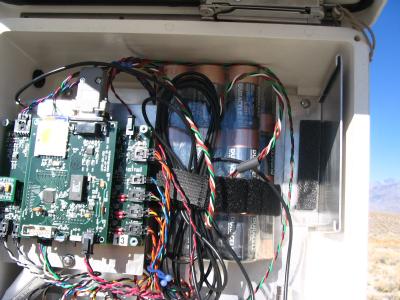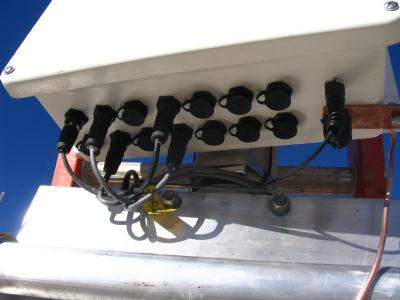
|
|
January 30, 2007 The DL4-Met Environmental Data Logger
Overview The DL4-Met, based on the DL1-Met is an improved low cost, low power environmental data logger with additional sensor channels, integrated GPS and telemetry system. The DL4-Met is being developed by the Technology Application Group at the Scripps Institution of Oceanography (SIO) Hydraulics Laboratory in collaboration with Drs. Dan Cayan and Mike Dettinger of the SIO Climate Research Division and U.S. Geological Survey for remote meteorological and hydrological monitoring applications. Funding for this project is provided by the California Energy Commission. This new version of the data logger is the descendent of the DL1-Met data logger, several of which are still logging meteorological data in the Santa Margarita Ecological Reserve (SMER), UCSD, and Camp Pendleton, and are transmitting in near-real time mode via SMER-net and HPWREN; data can be seen at http://meteora.ucsd.edu/weather/observations/sio_other/crd_obs.html. As with the older version of the logger, the DL4-Met telemetry system provides near real-time access to the data from remote installations. Nine DL4-Met loggers installed in southern and central California are currently operational collecting meteorological and stream gage data at one minute sampling intervals. Data from the loggers are transmitted by spread spectrum wireless modems to the Internet and then forwarded into a dynamic data file system at SIO. Logger Design One of the major differences with this logger design with previous designs is the use of a stacked configuration of main board and plug in modules rather than one single circuit board. The main board, DL4-GP, is responsible for the high level functions of the system. On it can be found the microcontroller, real-time clock, data storage, and user interface circuitry. The DL4-GP is designed to plug into Application Specific Interface Modules (ASIM), which provide sensor interface circuitry and additional capabilities to the system. ASIM units can be tailored to meet specific scientific goals. The DL4-IO1-Met allows for a more diverse suite of environmental sensors to connect to the logger. The DL4-IO2-GPS-COMM provides an interface to a Trimble Lassen iQ GPS Module and two additional asynchronous RS-232 Serial Ports.
All of the sensor inputs have been redesigned to provide better protection from lightning strikes. In addition, the GPS on the logger allows the system to automatically set its clock should the system reset for any reason. System resets, which were infrequently caused by nearby lightning strikes, were an issue with the DL1-Met. The temperatures, humidity, winds, and solar radiation are sampled each second and averaged over the minute. Maximum gusts for winds are stored along with the average wind values. Barometric pressure is measured once per minute. Precipitation is stored as a running total. Soil Moisture and Fuel Moisture are each measured once per hour. Data are continuously logged and stored internally, and, a subset is transmitted via a wireless network. The logger uses a Secure Digital (SD) for data storage. SD cards are non-volatile, removable storage media that are in common use in many digital cameras. MMC cards used in previous designs are compatible with the SD card format. The current design uses a 128 MB SD card but any size SD card can be used. Under the one minute sampling rate operating on the present suite of 19 variables, a 128 MB card allows the logger to record almost eight years of data. Prior to logger deployment a computer is used to format the SD card, and write a blank data file to it. This obviates the additional development required to design and implement a file system on the logger. The data are written in 512 byte blocks starting at the first unwritten sector of the data file. Each block includes a header with logger number, date and time stamp, and battery voltage. The rest of the block is filled with sensor data records from the previous 16 minutes of sampling. The recorded data file can be read from the SD card at the end of the deployment with any computer that supports SD cards. Quiescent power consumption of the full system is on the order of 2 mA with peak power consumption jumping to 900 mA when the 1W radio is operational. An alkaline D cell battery pack is presently used to power the logger, although, alternate sources of powers such as solar or AC can also be used to power the logger and extend the time it can be deployed. The alkaline battery pack is made up of 12 D-cells: two parallel banks of six cells in series. Battery life is projected at one and a half years given 75% efficiencies of the batteries and power supplies. .
The logger, telemetry unit, and batteries are housed in an inexpensive, fiberglass, waterproof enclosure with seal (Figure 1). All of the external sensors are cabled back to the enclosure and connect using water resistant connectors (Figure 2). An antenna cable connected to the telemetry unit runs from the enclosure up to a 9dB directional YAGI antenna at the top of the tower. Telemetry between the logger and the hub is provided by MaxStream XStream 100mW or XTend 1W Wireless Modems ( www.maxstream.net). The MaxStream modems operate in the 900 MHz license free ISM band. When using YAGI directional antennas the 100 mW units have a potential transmission range of up 32 km (20 miles), and, the 1W units have a potential transmissions range of up to 64 km (40 miles). Field Testing In the fall of 2006, Alden along with Spencer Kawamoto and Jim Wells, installed seven DL4-Mets along the Piute Creek drainage in the White Mountains north-east of Bishop. These units were installed in collaboration with the White Mountain Research Station (WMRS) Owens Valley Laboratory east of Bishop California. WMRS is a multi-campus research unit of the University of California Office of Research. The DL4-Mets in the White Mountains were installed on 4m high aluminum poles (Figure 3). Data have been streaming from five of the White Mountains sites since early December. The last of the currently installed nine DL4-Mets was used to replace the DL1-Met on the SIO Pier on the campus of the University of California, San Diego. The SIO Pier site is extensively used as a test bed for inter-comparison with other met systems and continued logger development.
Future Plans At SMER, for some of the existing meteorological stations, old DL1-Met loggers will be replaced with DL4-Met loggers, which will accomodate new fuel moisture and soil moisture sensors. Future improvements to the logger are planned. In the near term, these include include developing a new ASIM for the acquisition of data from electronic dendrometers to measure sap flow in plant stems, and integrating mesh network capabilities using ZigBee radios from Maxstream to allow several DL4 loggers to talk to one another and pass data from snow depth sensors D.J. Alden, D.R.Cayan, M. D. Dettinger
|


